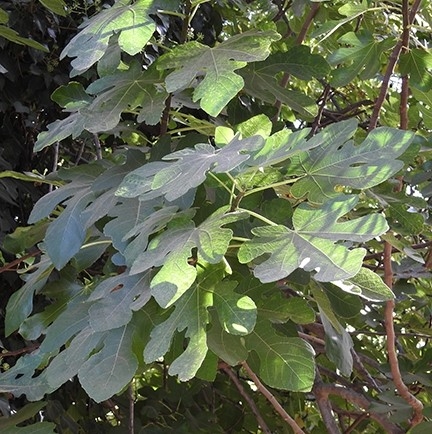Sometimes distant relationships are better than close relationships.
https://ucanr.edu/blogs/blogcore/postdetail.cfm?postnum=43912
Persimmons, asparagus, figs and other crops distantly related to native California plants attract fewer pests and diseases than the closer kin, and thus receive fewer pesticide treatments, according to a newly published article by two UC Davis-linked scientists in the Proceedings of the Natural Academy of Sciences (PNAS).
Co-authors Ian Pearse, research ecologist with the U.S. Geological Survey and a UC Davis alumnus, and Jay Rosenheim, UC Davis distinguished professor of entomology, analyzed the 2011-2015 state records of pesticide applications of 93 major California crops.
“We hypothesized that California crops that lack close relatives in the native flora will be attacked by fewer herbivores and pathogens and require less pesticide use,” said Rosenheim, a 32-year member of the UC Davis Department of Entomology and Nematology faculty and a newly elected fellow of the Entomological Society of America.
Rosenheim and Pearse examined the pesticide applications against arthropods, pathogens, and weed plants and compiled the data into a comprehensive analysis.
Their findings appear in the PNAS article, “Phylogenetic Escape from Pests Reduces Pesticides on Some Crop Plants,” published Oct. 12. “Phylogenetic relationship” refers to the relative times in the past that species shared common ancestors.
“It is well understood that many of the insect pests and diseases that attack our crops are often invasive species that come from overseas,” Rosenheim explained. “Almost all crops grown in California have been domesticated from wild plants whose area of origin is overseas, and many of the invading pests come from the original home of the wild ancestor of the now domesticated crop plant.”
“In contrast, our study focuses on the roughly half of all herbivores and diseases that attack California crops and that are actually native to California. These organisms originally attacked members of the native California flora, but have now shifted to attack a novel host: the crop plant.”
However, “host shifts aren't always easy,” Rosenheim said. “It's relatively easy to shift to attack a close relative of a native host plant, but it's relatively hard to shift to attack a very different host plant.”
Said Pearse: “Our study shows that crops like dates, asparagus, figs, kiwis, or persimmons that are distantly related to native California plants--and thus separated by many million years of independent evolution-- are colonized by fewer pests and diseases.”
These crop plants, the scientists said, are “too different” to be attacked readily. As a result, fewer pesticide applications are needed to protect those crops. “Thus, we can capitalize on an understanding of the evolutionary relatedness of crops and native plants to find crops that will suffer less attack, and that can therefore be grown with less use of toxic pesticides,” Pearse pointed out.
"The crops that require the most pesticide applications, Pearse said, "are those, like artichokes, blackberries, and sweet corn, that have close relatives in the Californian flora and are of high economic value per acre."
California's top agricultural crops include almonds, grapes, lettuce, strawberries, tomatoes and walnuts.
Rosenheim said persimmons are a good example “of the phenomenon we've studied: they have very, very few pests--almost zero in my experience--and that's probably because persimmons have no close relatives in the California native plant community.”
Pearse, a 2005 Fulbright scholar who received his doctorate in ecology from UC Davis in 2011, studying with Professor Rick Karban, joined the U.S. Geological Survey in Fort Collins in 2016. He focuses his research on invasive species and plant-insect interactions. Rosenheim researches insect ecology, with a focus on host-parasitoid, predator-prey, and plant-insect interactions, with direct applications to biological control.
“Pesticides are a ubiquitous (found everywhere) component of conventional crop production but come with considerable economic and ecological costs. We tested the hypothesis that variation in pesticide use among crop species is a function of crop economics and the phylogenetic relationship of a crop to native plants, because unrelated crops accrue fewer herbivores and pathogens. Comparative analyses of a dataset of 93 Californian crops showed that more valuable crops and crops with close relatives in the native plant flora received greater pesticide use, explaining roughly half of the variance in pesticide use among crops against pathogens and herbivores. Phylogenetic escape from arthropod and pathogen pests results in lower pesticides, suggesting that the introduced status of some crops can be leveraged to reduce pesticides.”
Coffee, anyone?
Attached Images:
